You don’t need a water cooler and employees don’t even have to be in the workplace to participate in water cooler talk. Learn how from our 10 top tips.

.png)
Strategy is an important component of internal communications. Ensure you’re communicating through the right channels at the right frequency with our Internal Communications Channel Audit worksheet.
Access NowThe water cooler has been around for nearly a century, and while not originally defined as such, so too has “water cooler talk.” But both the water cooler and water cooler talk have changed a lot — especially since the COVID-19 pandemic and the substantially notable growth of remote work globally.
One of the best ways to improve company culture and bring employees together on a personal level is by encouraging the water cooler chat.
One aspect highlighted by Christine Porath and Carla Piñeyro Sublettt in a 2022 article in Harvard Business Review (HBR) is the isolation so many employees experienced during the pandemic. In Rekindling a Sense of Community at Work, they report the results of a survey that shows how 37% of respondents said that since the pandemic, their sense of community has declined. At the same time, those who did have a sense of community were 55% more engaged, and 66% were more likely to stay with the organization that employed them. They were also significantly less stressed and much more likely to thrive outside of work.

HBR and multiple other research studies show that frequent catch-ups between co-workers and others in the workplace help to create a sense of community, a more relaxed and productive work environment, and a much better employee retention rate.
But what exactly is "water cooler talk"? And how does it benefit the workplace - be it physical or virtual?
We’re going to look more closely at water cooler talk and offer insights and advice to both employees and managers alike. Besides exploring its meaning and importance, we will also suggest exciting and inclusive topics, and share some practical tips to help ensure that every informal water cooler chat becomes a positive and beneficial part of your workplace culture.
Before we discuss water cooler talk, let’s dig into the origins of the water cooler itself. After all, this is where it all began.
Invented and introduced by American sanitary inspector Luther Haws in 1938, the water cooler has evolved, not only in design, but also significance, since that time. From an innovative machine used for cooling and dispersing water in the workplace, it quickly became a spot where employees would meet, chat, gossip, and brainstorm.
Of course, it wasn’t only the location of the water cooler where colleagues would gather. Employeesalso met around coffee vending machines, as well as other shared spaces and breakaway areas. But the term water cooler stuck. While still defined as a device for cooling and dispensing drinking water, the term also indicates the kind of informal conversation among office staff that takes place at this commonly used dispenser — and other parts of the office or workplace.
There are some who cite Steve Jobs, cofounder of Apple, as someone who promoted a kind of water cooler environment in his workplace environment. While CEO of Pixar, he created a centralized atrium, including a cage where people from different departments were literally forced to “see” each other. His idea was to promote encounters and unplanned collaborations. Feedback from John Lasseter, Pixar’s former CCO is that it worked wonderfully, promoting collaboration and creativity.
Some say it is (or was); others say it’s a myth. This is largely because many companies were hoping for a “water cooler moment” that would lead to a million-dollar idea. This idea appears to have originated in a 1997 “photocopier encounter” between Prof. Katalin Kariko and Dr. Drew Wiessman, whose initial chit-chat led to Pfizer and Moderna vaccines. It didn’t happen at a water cooler, but it might just as well have done! The two worked in different facilities in the same company, and they might never have “found” each other had it not been for this chance encounter.
Claire Cain Miller takes this idea a step further in an article featured in The New York Times, When Chance Encounters at the Water Cooler Are Most Useful. She illustrates how research suggests that initial meetings with people in person are “helpful,” especially when people don’t work together closely. While the million-dollar inspiration theory maintains chance meetings are essential for innovation, Jamie Dimon, chairman and Ceo of JPMorgan Chase & Co. is more than cynical about the impact of remote work.
“Remote work virtually eliminates spontaneous learning and creativity because you don’t run into people at the coffee machine, talk with clients in unplanned scenarios, or travel to meet with customers and employees for feedback on your products and services.” Jamie Dimon, JPMorgan Chase
It’s difficult to quantify creativity. But as Claire Miller says, water cooler conversations can help to establish new relationships and reinforce those that already exist.
Strategist and industry analyst, Daniel W. Rasmus suggests a myth of water cooler innovation. While using “technology and space will create more encounters,” the water cooler won’t “create all possible encounters.”
Without any doubt, it’s also going to depend on the conversation!
Upgrade your company’s internal comms to enhance employee communication
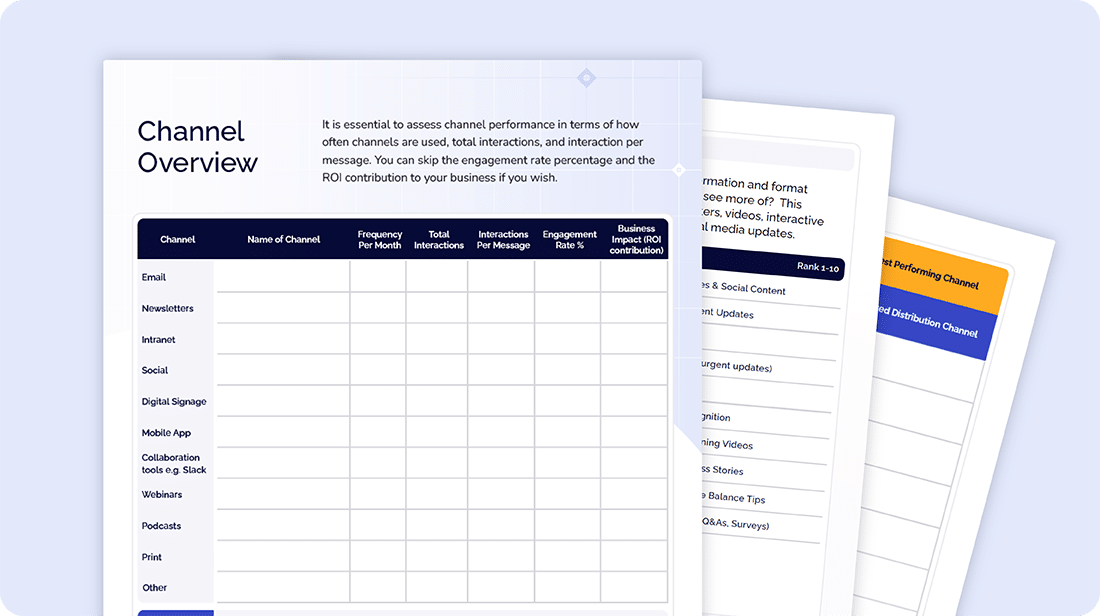
You'll often find staff members congregating around the office water cooler engaging in casual chit-chat. This is the phenomenon we call water cooler talk that refers to informal conversations between colleagues that typically occur spontaneously in common areas in the workplace. It generally involves casual discussions on non-work topics that employees engage in during free moments throughout their workdays.
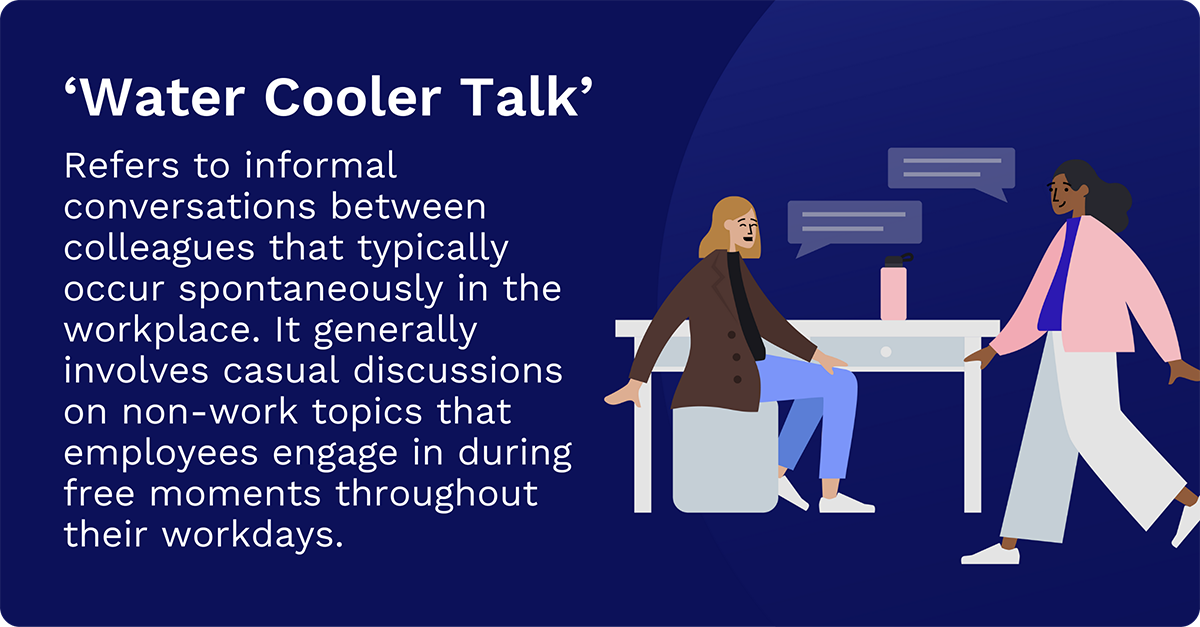
Water cooler conversations might be mistaken for superficial dialogue. But they are a quintessential part of the office dynamics. They contribute significantly to building an inclusive company culture as they create opportunities for employees to bond over shared interests and experiences.
Research published in mid-2023 found that the factors influencing team social networking improve performance levels by 43.6%. So, this in itself is hugely important — as is the still developing importance of water cooler talk.
With the shift to remote work brought about by the recent pandemic, the water cooler conversation has transcended the physical office space. Virtual platforms like Microsoft Teams now host these casual conversations, giving remote and hybrid teams a chance to build working relationships in an informal setting — around a virtual water cooler.
Furthermore, ongoing academic research shows that there are four areas of thought that may be virtually funneled through an imaginary water cooler:
This shows we still have a lot to learn.
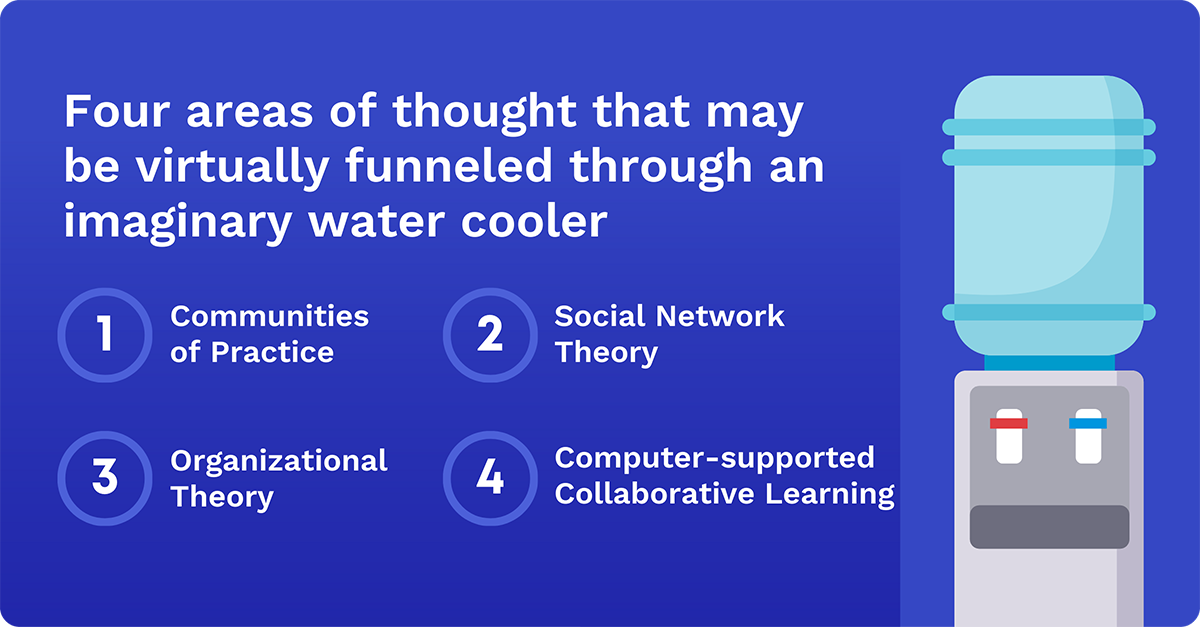
In a world that increasingly values strong internal communications, water cooler talk can play a bigger role than you might ever imagine. Let's explore some of the benefits it offers.
Water cooler conversations form a critical component of any organization's internal communication strategy. Employees feel comfortable sharing their thoughts and ideas during these casual chats, enhancing transparency across all levels.
Only 23% of employees (globally) or 31% in the US are actively engaged, according to Gallup’s State of the Global Workplace: 2023 Report.
When employees engage in water cooler chat, it promotes a sense of community and togetherness, making individuals feel valued and engaged. It can also contribute significantly to employee morale and happiness, enhancing overall employee engagement.
Water cooler chats provide an opportunity for newer team members to acclimatize to company culture. They get a feel for the company's ethos and values, leading to deeper cultural integration.
Sharing industry news, brainstorming great ideas, or even talking about a recent webinar can spark creative thoughts and foster a culture of continuous learning and development. In this way, water cooler talk serves as an informal yet effective platform for knowledge sharing.
Building strong working relationships is essential to collaborative success. Water cooler conversation provides team members with an opportunity to connect on a more personal basis, thereby fostering team bonding.
According to Achievers Workforce Institute 2023 Engagement and Retention Report the second reason employees would want to stay is the sense of belonging.
Water cooler chats can often transform into unplanned brainstorming sessions. As employees discuss work-related matters informally, it may lead to the emergence of innovative solutions. Thus, these chats could serve as hubs of informal collaboration.
A positive working environment promotes employee retention. As water cooler talk enhances communication, engagement, and team bonding, it goes beyond doubt that it aids in retaining talent in the company.
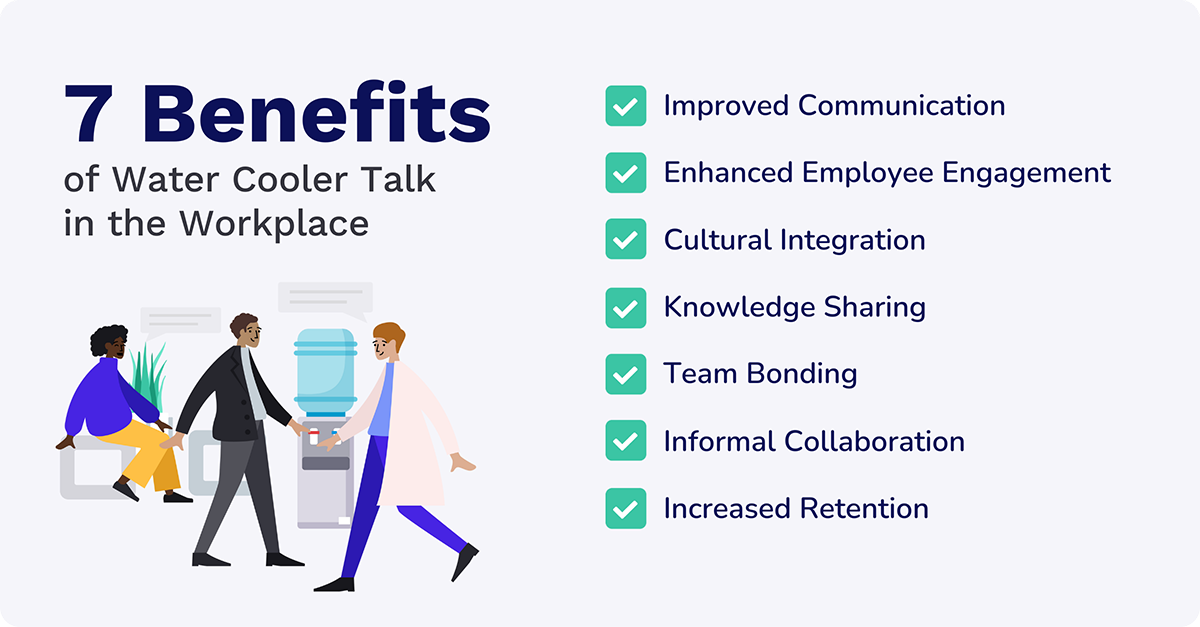
As staff members file by the water cooler in a physical office or pause in a virtual chat channel, the conversation can swing in a variety of directions. It's important to focus on topics that encourage camaraderie and bonding. Here are a few topics to consider when contributing to water cooler chats.
Discussing recent weekend highlights is an effective way to start a conversation. Questions like, "What was the best part of your weekend?" can result in interesting and diverse responses. It helps team members to feel comfortable expressing themselves and furthers understanding on a personal level.
Our interests and hobbies define a significant part of who we are. Ask your colleagues about their favorite hobbies, or upcoming interests they plan to explore. This sharing and discovery of mutual hobbies can lead to playful banter and deep conversation alike while promoting a positive company culture.
Travel experiences offer wonderful stories — tales of adventure, unexpected events, and stunning sights. This conversation topic allows employees to share their personal stories, introduce their colleagues to different cultures, and build strong working relationships.
Who doesn't love a good book recommendation or a spirited debate about the latest movie? Chatting about entertainment is a light-hearted way to engage all team members. It could also lead to riveting discussions about the themes and characters, and sometimes even bring out great ideas for team activities.
Forward-thinking conversations help establish a sense of camaraderie among team members. Discussing plans for the future can be inspiring and encouraging. Just be aware of not crossing any personal boundaries or making anyone feel uncomfortable.
Upgrade your company’s internal comms to enhance employee communication

Creating an engaging and inclusive conversation requires tact and respect. But don't worry, it's not as difficult as you might think. Here are ten best practices to help you navigate water cooler conversations effectively and increase employee engagement.
These apply to both in-person and virtual conversations.
Maintaining an approachable demeanor is crucial if you’re going to foster open communication. This includes making eye contact, displaying open body language, and exuding a positive attitude. A friendly demeanor encourages fellow team members to join the conversation and removes elements of social anxiety.
Conversations aren't just about talking. They are also about active listening. Showing genuine interest in what others have to say elevates the exchange from casual chit-chat to a meaningful interaction. This can be done by asking relevant follow-up questions or commenting positively (or meaningfully) on shared ideas.
To foster a sense of unity and collaboration, keep the conversation topics inclusive. It’s usually best to avoid divisive topics like politics or controversial current events. Remember, the aim is to build working relationships, not create divides. Focus on conversation topics that can involve everyone and respect the diversity of your team.
Save the heavy, work-related topics for formal meetings. Light-hearted, fun topics are the flavor of the day when it comes to water cooler chats. It's a time to relax, unwind, and share a laugh with colleagues. Use humor judiciously, as it helps in defusing tension and promoting a friendly atmosphere.
While it's great to know more about your colleagues, always remember to respect each other's boundaries. Avoid overly personal questions or any topics that may make others feel uncomfortable. Respecting personal boundaries fosters mutual trust and enhances the overall relationships amongst the team.
Water cooler conversations aren't just for fun — they are a great time to share insights and learn from each other. Discussing interests and hobbies may lead to unexpected revelations and great ideas. Always be open to learning new things from your colleagues and be sure to share your knowledge too.
Maintaining positivity is the key to a healthy water cooler conversation. The aim is to create a refreshing break from work; keep the negative remark and work complaints for other platforms. A positive attitude can help to uplift the mood and keep the conversation flowing effortlessly.
Diversity is a strength in any workplace. Utilize your water cooler conversations to appreciate and learn from the diverse backgrounds, cultures, and experiences of your colleagues. Encouraging diversity sparks interesting discussions, promotes mutual respect, and produces a well-rounded workforce.
While engaging in water cooler chats, it's crucial to respect not only personal boundaries but also time boundaries. Keep in mind the primary purpose of your work chats and try to keep your water cooler talk concise and engaging.
Try using this informal chat time to plan fun team-building activities. Want to start a book club based on shared literary interests? Or arrange a virtual lunch for remote workers? Water cooler chat could be the perfect way to organize and initiate these activities.

As part of the new era of remote and hybrid working, our Comms App when integrated with a chat or Intranet presents an innovative solution for fostering water cooler chats. This innovative app allows team members to retain the casual chit-chat nature of a physical office even when working remotely, and effectively reduces the proximity bias remote workers may experience. By creating a water cooler channel, the informal communications employees enjoy in physical offices can be replicated, thereby improving employee engagement and internal communications.
The core objective of a communications app water cooler channel is to provide staff members a designated space for informal chat on diverse topics. Through this, a sense of unity, camaraderie, and community can be cultivated, regardless of where team members are working from.
Find out more about ways Cerkl Broadcast can help ensure your communications strategy embraces the potential offered by water cooler talk.
We can also help you assess the effectiveness of your existing internal communications plan. All you have to do is complete our strategic internal communications audit. It’s quick, easy, and free.
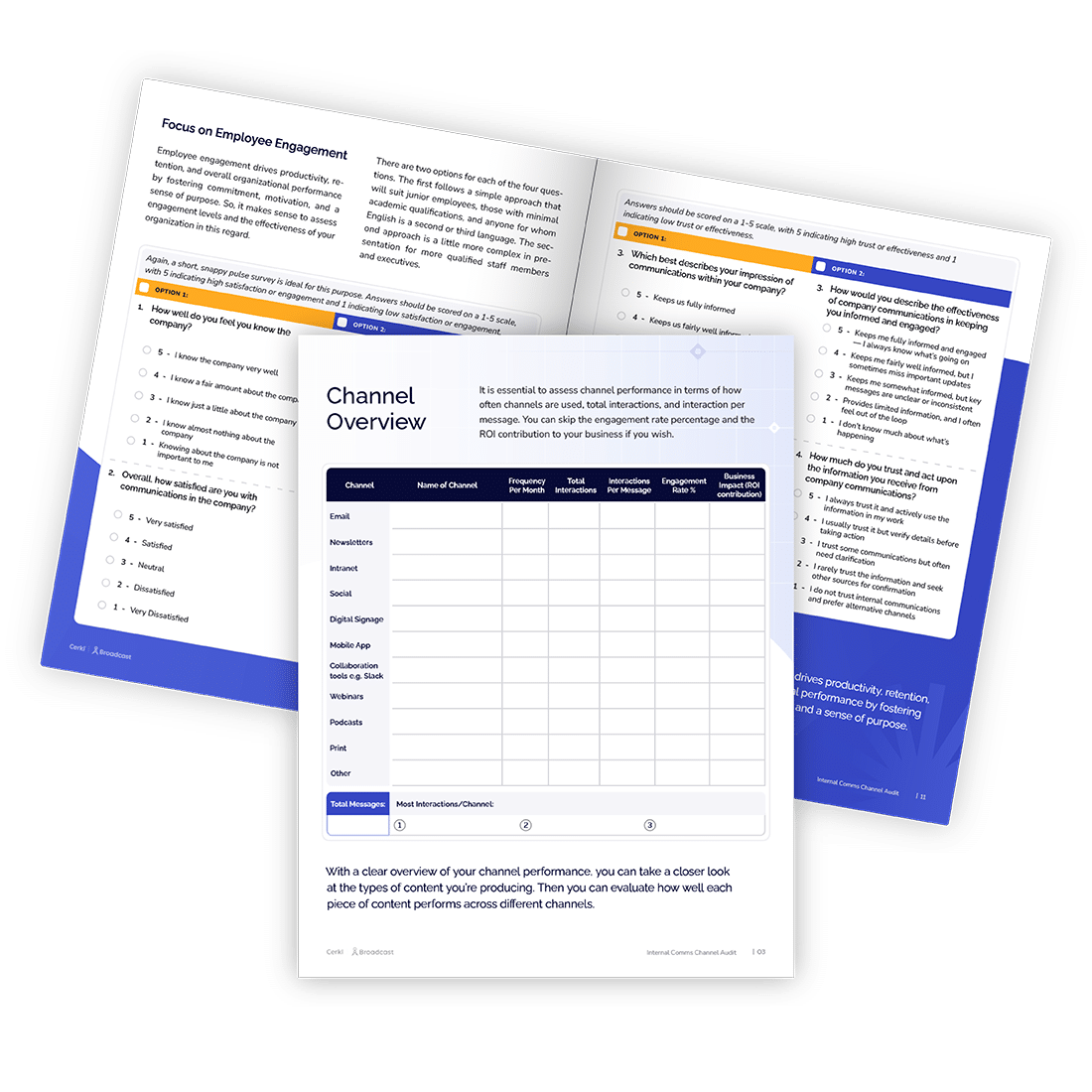
Upgrade your company’s internal comms to enhance employee communication
What does water cooler talk mean? This refers to casual and informal conversations that take place among colleagues in the workplace. They are typically centered around shared spaces like water coolers, break areas, or coffee machines.
What is the benefit of water cooler talk? Benefits include fostering a sense of camaraderie, promoting communication, and creating a more relaxed and positive work environment that can contribute to improved morale and team cohesion.
What is another way to say water cooler chat? Other ways to say water cooler chat include office chit-chat and breakroom banter. A lesser-known term is scuttlebutt, which is based on the long-standing tradition of 19th-century seafarers who gathered around the ship's drinking fountain (scuttlebutt) to gossip
What is a water cooler conversation? A water cooler conversation is an informal discussion that occurs in the workplace. It is often characterized by chats about non-work-related topics or personal experiences that provide employees with opportunities to connect on a more social level.

Upgrade your company’s internal comms to enhance employee communication